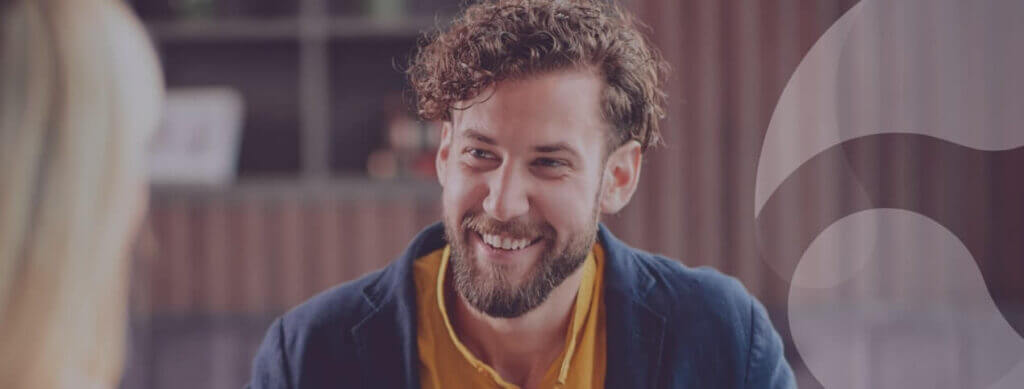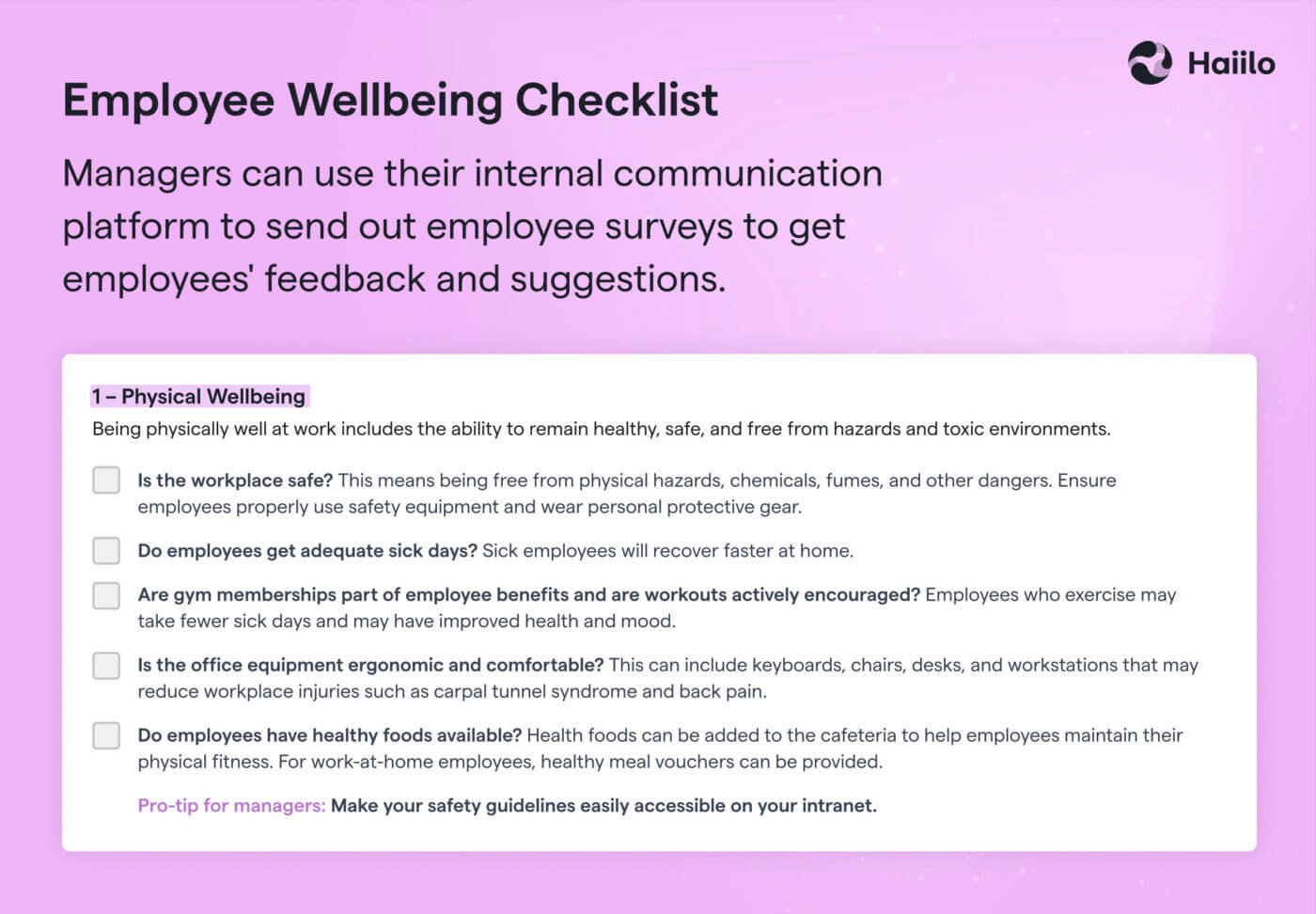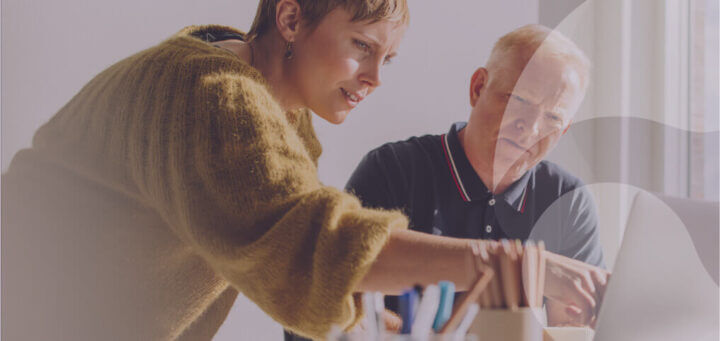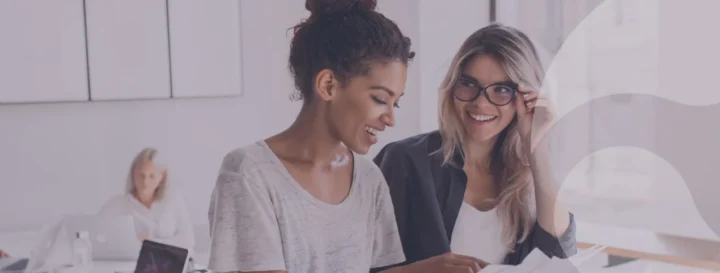Workplace safety has become one of the main priorities for organizations across the world. As safe workplaces are also productive ones, employers are trying to find new ways to keep their remote, frontline, and in-office employees safe and healthy.
In this blog, we will go over the importance of workplace safety as well as some of the best practices for ensuring safe work environments, including workplace safety communications.
💡Check out our article on 11 Reasons Why Business Communication is Critical to Your Company’s Success and learn how to improve communication in the workplace!
Make the safety guidelines easily accessible with a modern intranet in place
Workplace Safety Defined
Safety of workers (also known as worker safety and occupational health and safety) refers to the provision of a safe working environment, safe equipment, policies, and procedures in order to ensure workers’ health and safety.
In 2020, workplace safety has become one of the main concerns for many employers. Not only the COVID-19 pandemic is resulting in more illnesses, but the emergence of remote work and dispersed workplaces are making it harder for employers to reach their frontline and deskless employees.
A national survey by The Hartford Financial Services Group found that 58% of blue-collar households have “a family member who has been injured on the job, requiring medical attention.”
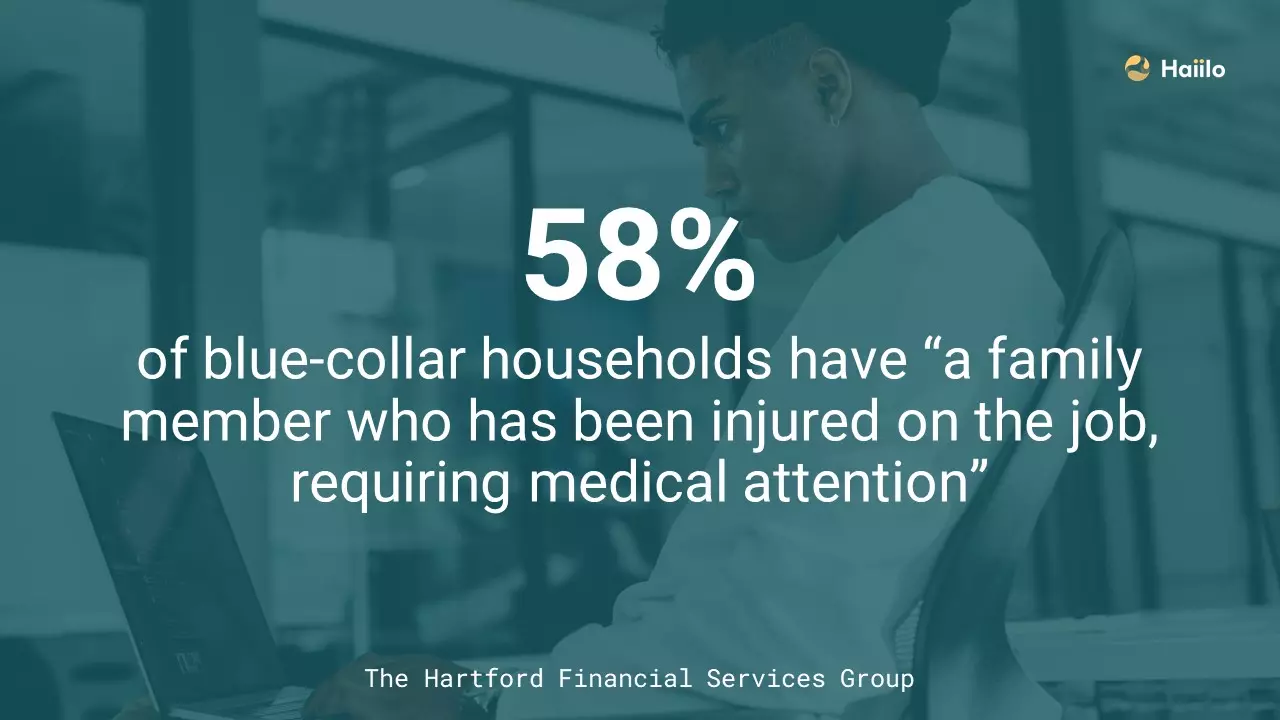
While organizations have a moral obligation to ensure safe working conditions, unsafe workplaces can also have serious legal and financial consequences for employers.
The Importance of Keeping Your Workplace Safe
Safety in the workplace has a significant impact on many business KPIs. In other words, safer working environments benefit from fewer accidents, which results in fewer occupational health costs, better employee retention and satisfaction, less employee downtime, and less retraining time.
Let’s now take a deeper dive into the importance of workplace safety.
Employee retention
Employees appreciate safe working environments, which is a sign that their employer cares about their wellbeing. Therefore, employees who feel safe at work are also more loyal to their employers and stay longer within their organizations.
On the other hand, those who don’t feel safe or have experienced workplace accidents are much more likely to search for new employers.
Company finances
The Liberty Mutual Workplace Safety Index reported that for every $1 a company invests in workplace safety, the result amounts to a $4 return on investment.
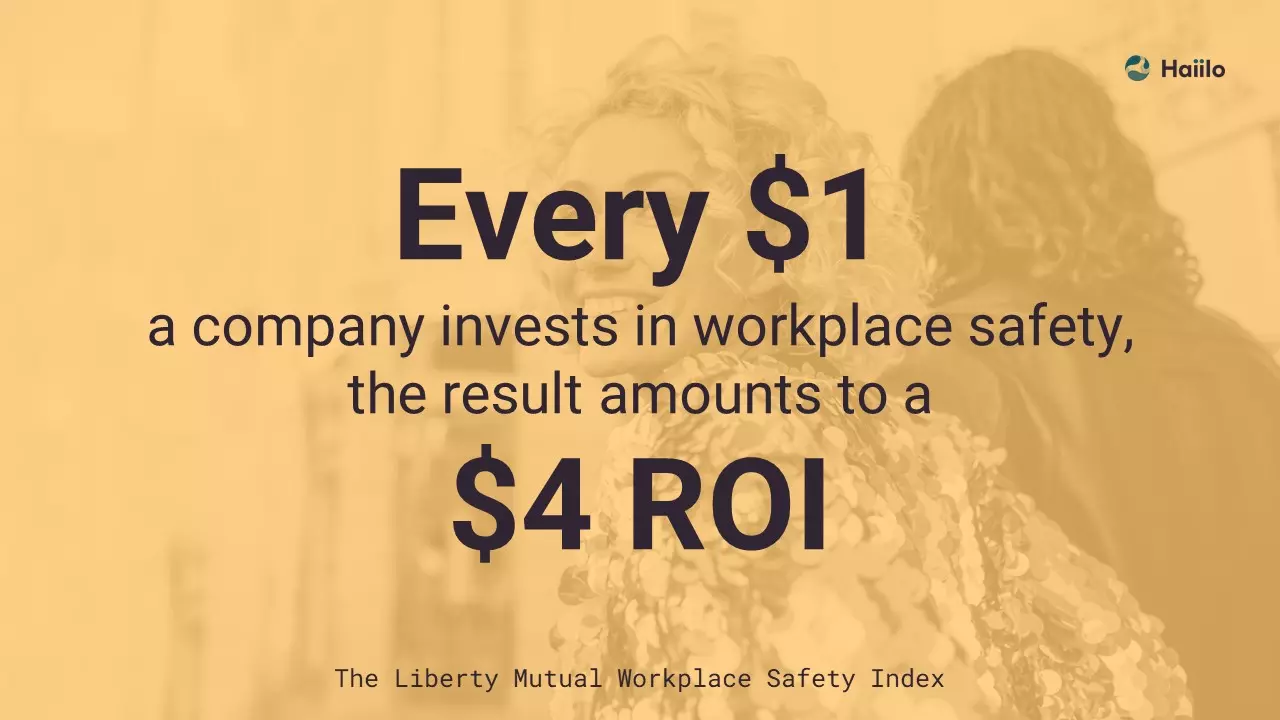
This is not surprising as a company could run into serious financial trouble if an employee gets injured at work. The federal Occupational Safety and Health Act (OSHA) requires all employers to follow specific guidelines in creating safe workplaces. Not following OSHA’s rules and guidelines can lead to serious legal and financial losses.
Employee productivity
Employees who feel safe in their working environments are also more productive than those who have been injured in the past and, therefore, have developed a certain level of anxiety and fright.
Eliminating workplace hazards enables employees to stay invested in their work and do their best.
Company reputation and Employer Branding
Companies that don’t invest in workplace safety quickly develop a reputation of an unsafe employer, which has a big impact on employer branding and talent attraction efforts. Moreover, the company’s customers, competitors and the general public often perceive such companies as unprofessional.
As a consequence, fewer employees apply for jobs, and the most skilled workers often search for jobs elsewhere.
12 Workplace Safety Best Practices
Organizations with employees who are at high risk of getting injured often have structured and well-designed workplace safety strategies in place. As they are aware of the consequences of neglecting workplace safety, they understand that having a good plan can significantly improve employees’ health, safety and wellbeing.
Let’s now take a look into some best practices for ensuring safe working conditions.
1. Identify all the workplace safety hazards
Before you even start building your workplace safety plan, it is important to define and understand all the potential sources of hazard in the workplace.
Identifying those safety hazards and issues is the first step in protecting employees in the workplace. Some of the most common hazards often include ergonomics, hazardous chemicals, mechanical problems, noise pollution, restricted visibility, dangers of falling and weather-related hazards.
2. Define safety policies and remind employees to follow them
After identifying all the possible workplace hazards, the next step is to define safety policies and procedures. Many organizations have safety handbooks that employees can use as a reference every time when in doubt.

However, creating such materials is not enough if your employees don’t consume and follow them. It is the employers’ job to continuously remind employees of the importance of following safety guidelines. Moreover, under OSHA regulations, employees are required to comply with the standards, rules, and regulations put in place by the employer.
3. Keep employees aligned to foster the culture of safety
Suppose you are trying to build an employee-centric workplace, ensure a positive employee experience and foster a culture of safety. In that case, all your employees, including leaders and managers, need to be aligned and on the same page. Here, employers often neglect the importance of open and transparent workplace communications.
Besides just having a clear plan and safety trainings, organizations need to find ways to embed new employee behaviors by delivering inspiring safety stories, communicating new safety programs and sharing the company’s successes.
4. Build a safety communication plan
Many organizations are now implementing safety communications as a core company value. This focus towards a safety-centric workplace improves not only employee morale but also the bottom line.

In order to build a strong culture of safety in the workplace, organizations need to build safety communication plans. In other words, your workplace safety strategy will be as successful as you manage to communicate it properly.
The safety communication plan should consist of a set of materials, important company updates, messages and other internal campaigns that need to be communicated to the right employees at the right time.
Besides timeliness, creating engaging and relevant content is crucial here. When creating your safety communications plan, always ask yourself these questions:
- What are the main messages we want to communicate?
- What are the important safety updates to be shared with employees?
- How and where important documentation should be stored and shared with employees?
- Which employees should be reached?
- How will we segment internal audiences to make sure that the right employee gets the right message at the right time?
- What type of content should we distribute to ensure high engagement?
- Which communication channels should we use to distribute the messages?
- Can we reach employees on their mobile phones in a matter of seconds?
- How will we recognize those who follow the guidelines in order to ensure better compliance among other employees?
- How will we measure the impact of our communication campaigns?
📙 Also read about the best practises for building a successful communication plan.
5. Involve leadership and encourage employees’ share of voice
Creating safe workplace environments starts at the top. Without the leadership’s buy-in, it is impossible to amplify the safety messages and encourage employees to follow them.
Senior leadership must set the communication standard by providing an open and transparent environment. Such environments facilitate and drive discussions that allow employees to offer suggestions, report concerns and feel empowered to contribute to the workplace safety programs.
6. Designate a health and safety representative
As some employees are reluctant to share their safety issues with their direct managers, some organizations appoint designated health and safety representatives.
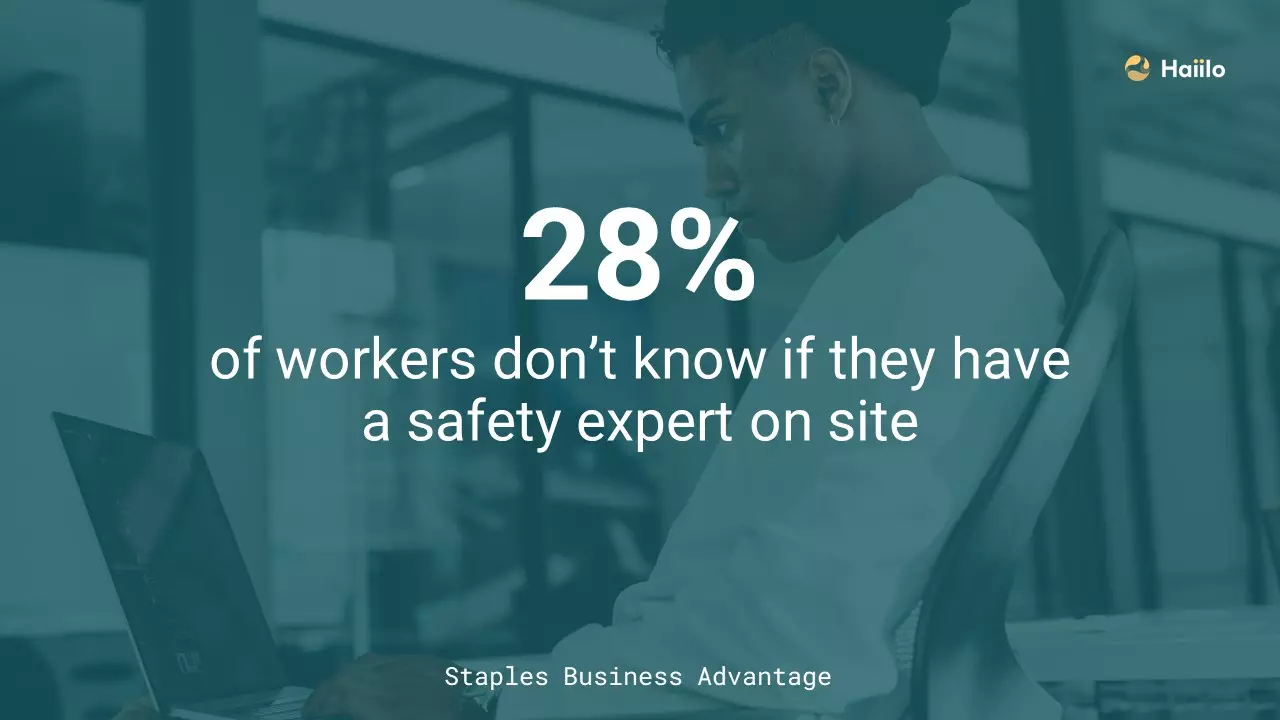
By doing so, employees can confidently and discreetly discuss their concerns with the representatives who act as a trusted intermediary between managers and employees.
However, employers are responsible for enabling these representatives to always be connected with employees, and making sure that they can reach out to them in a timely manner. Yet, many companies still don’t have access to the right technology that enables them to do so.
7. Build trust and be consistent
Fostering a safety-centric workplace environment begins by building trust in the workplace. Workers must be able to trust that their leaders’ number one priority is keeping their employees safe and that they can report to them if they notice any unsafe activity.
However, this type of employee behavior doesn’t happen over time, and a successful transition to an employee-centric workplace culture takes time to build. Honest, consistent and transparent workplace communication, as well as constant check-ins with employees, are the key.
8. Encourage engagement and participation from employees
The Safety Culture Survey administered to hundreds of organizations by Safety Performance Solutions Inc. (SPS) indicated that 90% of respondents believe employees should caution others when they’re operating at-risk. However, only 60% say they actually do provide this critical feedback.
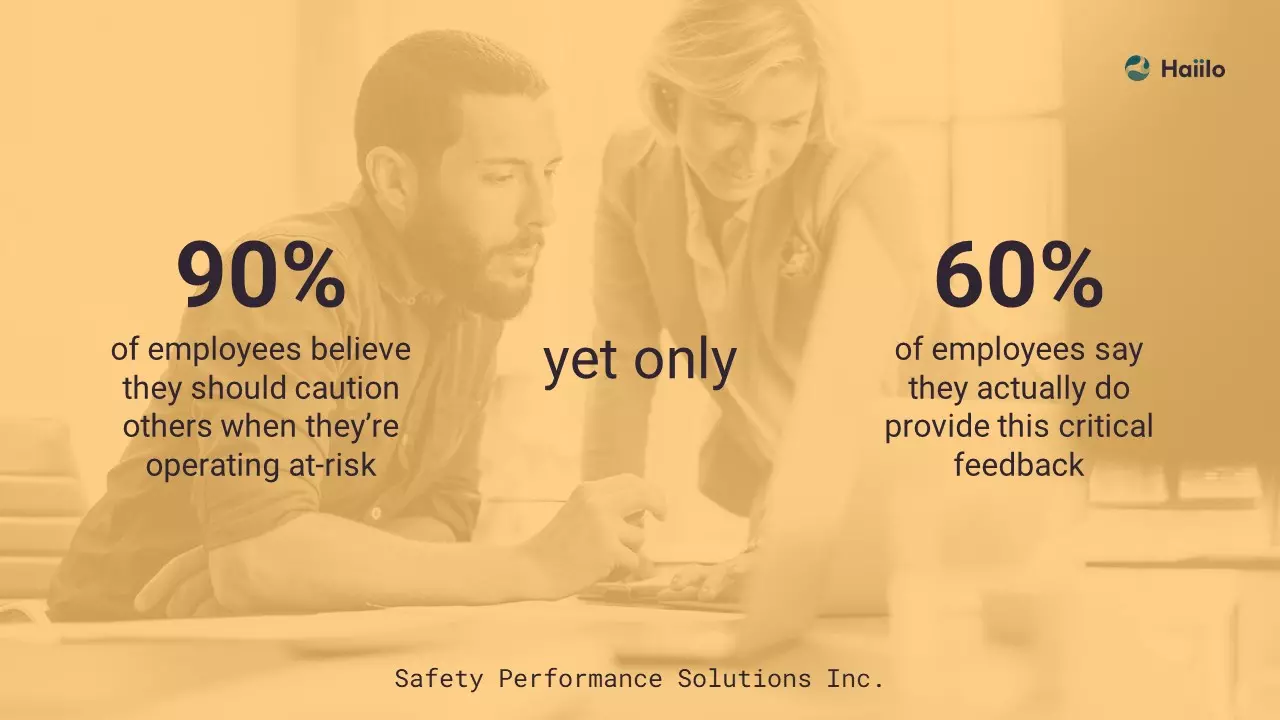
In fact, 74% of respondents (from the SPS Safety Culture Survey) confirm they welcome peer observations for the purposes of receiving safety-related feedback. Yet, only 28% believe other employees feel the same way.
Encouraging employees’ engagement, upward feedback, compliance and participation are key prerequisites in promoting and growing a positive safety culture in your workplace. Instead of leaving your employees out and just delivering safety guidelines one-way, consider involving your employees to directly participate in shaping a safer, risk-free working environment.
Here are a few tips for driving your employees engagement:
- Encourage your employees to suggest practical solutions and address their concerns in order to maximize safety.
- Enable and empower your employees to get involved in defining workplace policies and speak up about workplace safety issues.
- Ask them for feedback and urge them to report hazards and continuously.
- Continuously emphasize the importance of keeping themselves and their colleagues safe.
9. Enable easy access to important documents and information
Blue-collar workers are often the ones with the highest risk of getting injured at work. These employees spend most of their time outside of the company’s offices, and they often don’t have designated working spaces.
These, hard to reach employees, need to have instant access to all important safety materials and documentation available on their mobile phones. On the other hand, employers need to eliminate information overload.
Moreover, these employees should have access to personalized employee news feeds where they can consume content relevant to their job roles and potential hazards specific to their functions.
On the other hand, managers and safety representatives need to have a way to send instant updates, safety push notifications and the ability to automatically share content from credible safety sources such as OSHA.
10. Help managers and employees to always stay connected
It is important that you enable supervisors to keep employees informed about potential hazards or risks in the workplace. Managers should have the ability to create designated safety communication channels where they can share important information and communicate with their teams.

Similarly, when employees notice a potential hazard in the workplace, they should be able to instantly reach their fellow coworkers to inform and alarm them about the hazard.
11. Recognize those who follow the rules and regulations
In addition to keeping employees informed, it is important to praise and recognize those who regularly do their jobs safely. This builds a more open, positive safety culture and increases the likelihood that others will embed the same behaviors.
This culture of appreciation goes a long way when you want others to understand and support your plan. Share your employees successes and amplify positive examples, give public recognition and enable others in your organization to join the conversations.
12. Measure the impact of your safety communication campaigns
As mentioned earlier, communication in the workplace is the number one prerequisite for building and maintaining workplace safety. However, most organizations still don’t have ways to measure the impact of their safety communication campaigns on employees’ engagement and safety.
Luckily, employee communication solutions like Haiilo, enable internal communicators to connect their communication efforts with specific business goals. Robust, AI-powered technology, helps employers understand the real impact of communication on employees’ safety and also suggests some actionable insights and tips for improvement.
📙 Also read: Top 5 Communication Skills and How to Improve Them.
The Power of Technology in Ensuring Workplace Safety
In the past, workplace safety communications were often stored in binders, and it was impossible to always keep the information updated and accessible to everyone who needs it. In addition, it was extremely difficult to create and distribute engaging content that employees would want to consume.
With the emergence of new technology and digital workplaces, this is not the case any more. Today, it is much easier to ensure that safety information is always up-to-date and immediately accessible to employees at risk.
Furthermore, when using the right technology, employers can craft more creative and engaging communication campaigns while ensuring higher employee readership and, therefore, achieving higher efficiency and safety compliance.
Another big advantage of such employee apps is the ability to reach every employee, whether they are at their desk or on the factory floor, away on a business trip, or working remotely. Moreover, such technology can connect various internal communication channels into a single platform, ensuring that the right message reaches the right employees at the right time.
Another, often-overlooked, area of effective safety communication is the necessity to personalize communications based on employees roles, job functions, age, departments, languages that they speak and also their interests. This is also impossible to achieve without the right technology that enables robust workplace segmentation.
Fortunately, big safety binders with safety procedures and updates are dead, and digital solutions provide immediate and easy access to up-to-date safety documentation enabling quick response to critical issues or emergencies. Therefore, digital workplace communication is significantly streamlining employees’ access to safety documentation and Standard Operating Procedures.
10 Common Workplace Safety Tips for Employees
Even though every work environment is different and employees’ functions vary drastically, there are some most common workplace safety tips that employers often share with their workforce:
- Be aware of your legal responsibilities.
- Stay committed to health and safety at work.
- Get familiar with all the potential hazardous situations in the workplace.
- Often review the latest safety policies and procedures.
- Stay informed with the company’s safety updates.
- Identify, assess and manage hazards within the workplace.
- Inform, train and supervise your employees on safety practices.
- Ensure that incidents and injuries are reported, recorded and investigated.
- Share your concerns and feedback and suggest solutions for improvement.
- Ensure that you are planned and prepared for emergencies.
Top 10 Workplace Safety Threats by OSHA
Now that we have covered some of the best workplace safety practices and tips for employees, let’s take a look into the most common issues that cause hazardous workplace environments. According to OSHA, the top 10 areas for which citations are issued include:
- Forklifts
- Hazard communication
- Electrical wiring methods
- Electrical system design
- Guarding openings
- Exits
- Mechanical power transmission
- Respiratory protection
- Lockout/tagout
- Portable fire extinguishers


